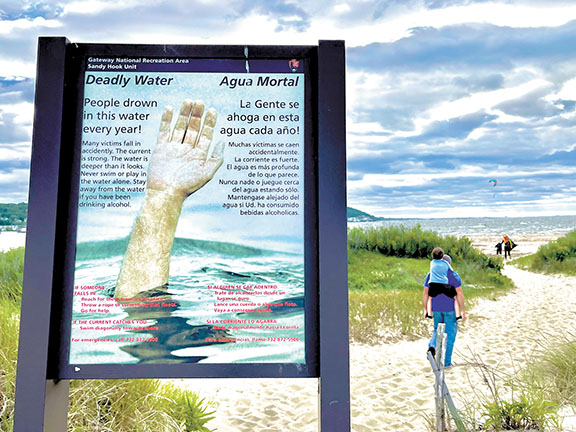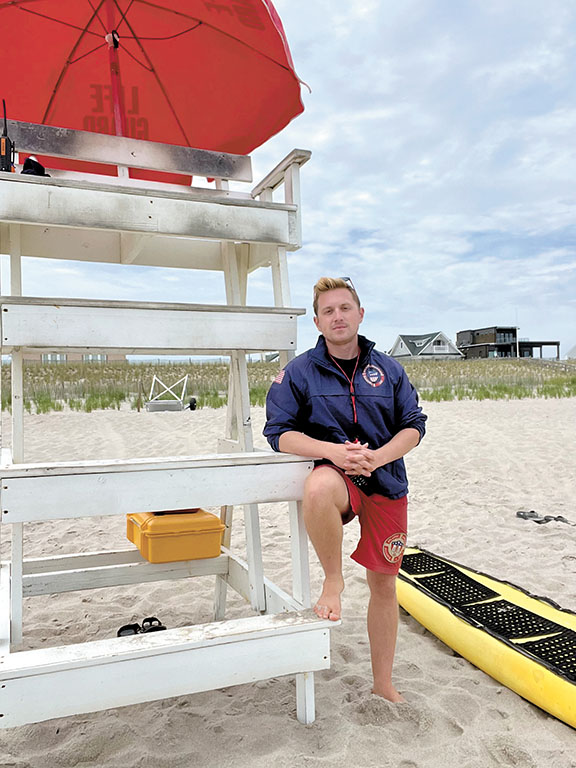
By Sunayana Prabhu
As summer hits, the Jersey Shore is getting busier. And crowds from the Two River area and beyond are bracing the waves with one of the worst lifeguard shortages the industry has seen. Whether you’re heading to the beach or your own backyard pool, going fishing or rowing, besides knowing how to swim, you may want to equip yourself with lifesaving information on water safety.
With summer nowhere near its peak, New Jersey has seen at least 14 drowning incidents since the last week of April. According to statistics from counties and multiple beach patrols from Jersey Shore beaches, rivers and reservoirs, 12 drownings were on the Jersey Shore with two additional reported pool drownings.
Recent reports published by the Centers for Disease Control (CDC) have the annual drowning death rate in the United States from 2015-19 at a little over one death per 100,000 people. That includes boating-related drowning deaths. For a state surrounded by water on one side, New Jersey surprisingly ranks below the national average, with 0.67 deaths per 100,000 in that same time period.
Swimming alone or without a lifeguard is strictly prohibited on most beaches, but swimmers continue to tempt fate, entering the ocean unprotected and unsupervised. A day at the beach can turn fatal if warning signs go unheeded. A national shortage of lifeguards only compounds this problem closer to home, with borough officials still looking to reach full capacity with lifeguarding staff.
“We employ anywhere from 35 to 40 lifeguards every year,” said David Stickle, mayor of Monmouth Beach. “We also staff not only the beach but a pool on the oceanfront. We are always looking to hire them. Last year we were fully staffed; this year we probably could use another five or six lifeguards.” He encourages beachgoers with experience to apply on the borough website.
Beaches in the Two River area, including on Sandy Hook, in Sea Bright and Monmouth Beach, are struggling to fill lifeguard positions.
Although beaches display bold signs warning swimmers of life-threatening, rapid water currents, reckless swimmers often just “hear the whistle and wave us away,” said Colin Regn, founder and CEO, Atlantic Lifeguard Alliance. Regn apologized for the beach winds interrupting his voice during a phone interview with The Two River Times. “I’m actually on the beach right now, sitting on one of my lifeguard stands. Because we are so short-staffed, I was helping them run breaks today.”
Regn lives in Eatontown but has been covering the Jersey coastline as far south as Mantoloking. “I’ve been doing this for 18 years,” he said. He partly attributes the shortage of lifeguards to wages.
“The pay for lifeguards, unfortunately, has lacked for a long time. Whether you’re a township agency or a private agency, it’s difficult to increase your pay rate without affecting somebody. So, for a township, you need to convince your municipal board to increase your rate of pay. And if you’re a private entity, that means that you need to pass the cost off to your clients, and they might just not use your service anymore at that point,” Regn said.
Contrary to the perception of some who believe lifeguard positions are just for teens and college-age students who spend the summer sitting on tall chairs tanning and texting their friends, Regn said there is a very high standard for hiring lifeguards. “Everybody that comes on has to get a 21-hour first aid certification, that’s almost equivalent to an EMT,” Regn explained. In addition, applicants must have advanced first aid and CPR training for professional rescuer training. “And then they have to become capable of passing what most people would consider a very difficult swim test. So, they have to do a 500-meter swim in 10 minutes, they have to do a mile run on the sand, and then they have to do 40 hours of ocean rescue training just before they even get the job.”
“Why would you go through all that if the pay isn’t that high?” he asked.
Regn also suggests that nearly two and a half years after the COVID-19 pandemic started, attitudes have changed about the jobs people choose.
“People are almost weary to go back into such high-liability jobs. The responsibility for lifeguards is enormous. We’re in charge of preventing tragedy. And a lot of times, these young adults between ages 16 and 22 are in charge of 100 adults far older than them. It’s very intimidating. Being so secluded for so long has made that even worse,” Regn said.
Considering the lifeguard shortage and recent string of drownings on the Jersey Shore, the American Red Cross issued a statement urging people to learn water safety skills because “drowning behavior is typically fast and silent. Unless rescued, a drowning person will last only 20 to 60 seconds before submerging.”
The Red Cross encourages families to use its in-person and online resources to stay safe. Its website, redcross.org/watersafety, has a Learn-to-Swim map where community members can find their local swimming instructors. CPR and first aid skills are offered to handle emergencies, as well as a swim app with kid-friendly videos and activities on water safety and a free online course on water safety for parents and caregivers, in both English and Spanish.
Preventing unsupervised access to water must take top priority, said Diane Concannon, communications director, American Red Cross, New Jersey Region. “Make sure that you’re swimming with a buddy and, for parents especially, always designate what we call a ‘water watcher.’ A ‘water watcher’ is a person whose sole responsibility is to keep a close eye and constant attention on everyone in and around the water until the next ‘water watcher’ takes over. So, whether you’re at the beach or in your backyard pool, one adult should always be the ‘water watcher,’ whether it’s for 15 minutes or an hour, designate someone in that role.”
Concannon also suggests swimming in pairs as another good way to reduce drowning risk, but be careful if the swimming partner gets into trouble. She said they’ve seen drowning victims pull their potential rescuers underwater with them. “Sadly, we’ve seen some instances where more than one person has drowned because one person got into trouble and the other tried to help.”
She is quick to add catchy phrases with an easy recall value for both children and adults. “ ‘Reach or throw, don’t go,” is a phrase to remember in an emergency. If you’re in a pool, think about reaching the swimmer with a pool skimmer (or lifesaving ring) and have them grab onto it.”
Families that plan to sail along the rivers this summer might want to think about how many times they’ve packed their personal flotation devices (PFDs) – commonly called life jackets – on a boat and not worn them. The Red Cross recommends wearing your PFD at all times while on a boat. Properly-fitted U.S. Coast Guard-approved PFDs offer an extra layer of protection, particularly for inexperienced or nonswimmers.
Summer is supposed to be fun, not fatal, so in the absence of a lifeguard, approaching waters with caution, the right knowledge and skills can truly save a life, perhaps even your own.
The article originally appeared in the June 23 – 29, 2022 print edition of The Two River Times.















